After some time of playing an acoustic guitar, you might want to make the switch to an electric guitar. Making the switch might be overly expensive if you’re on a tight budget, in which case, it might be convenient if you could only somehow convert your acoustic guitar to an electric one. Well, if that is you, you will be pleased to learn that you can make your acoustic guitar sound like an electric guitar.
To transform an acoustic into an electric guitar, you first have to turn it into an electric-acoustic one. After that, you should plug it into an electric guitar amp and put the emphasis on high tones while eliminating bass tones. You can use effects such as delay, reverb, and compression.
Whether you’re on a tight budget or a lover of DIY projects who would like to electrify his acoustic guitar, you’re in the right place. We’ll give you a step-by-step guide on what to do to turn your acoustic guitar into a proper electric guitar.
👇😀👇NOTE👇😀👇
If you want to find out what my recommended guitar gear is, then here is what I recommend on Amazon:
- Fender Cutaway Acoustic-Electric Guitar Bundle (MY FAVORITE GUITAR)
- Snark SN-8 Super Tight All Instrument Tuner (Easiest Tuner I’ve Used😏)
- 6 String Acoustic Guitar Capo (Best CAPO for quick changes)
- Dunlop Max Grip 1.0mm Nylon Picks (Thick Guitar Pick So You Don’t Lose Grip!)
- Universal Guitar Stand (Cheap & Minimalist Guitar Stand I Recommend)
- Levy’s 2″ Wide Quick Adjust Guitar Strap (Best Guitar Strap For Any Level)
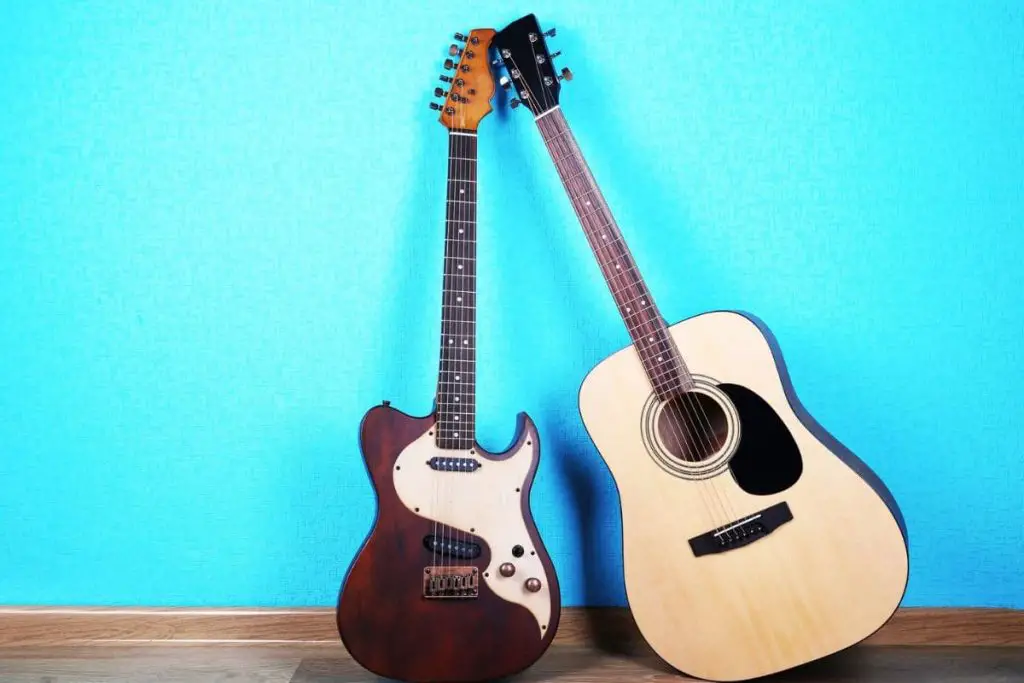
1. Turn It Into an Electric-Acoustic Guitar
The first step toward turning your acoustic into an electric guitar is making it electric-acoustic. This step boils down to installing a pickup in your acoustic guitar and suppressing feedback to increase sound quality.
There are multiple pickup choices, and what you choose will determine whether this project will be successful or not.
There are three types of pickups you can get:
- Clip-on pickups
- Piezo pickups
- Soundhole pickups
Let’s examine these pickups and see which one is the best option.
Clip-On Pickups
Clip-on pickups are the cheapest and easiest way to add a pickup to your acoustic guitar. As the name suggests, you are supposed to simply clip them onto the soundhole under the strings, and they should work just like any other type of pickup. They’re also called microphone pickups for this reason.
While they’re theoretically easy to install, it might be difficult to find the right place to attach them to get them to work as best they can. Additionally, the wires can get in the way 一 they don’t look particularly nice, which might be another deterrent.
They can give you a decent sound compared to the price (and some are ridiculously cheap), but it won’t be as good as the sound you might get from another pickup. A clip-on pickup might be right for you if you’re on a very tight budget. Otherwise, it might be smart to go for something else.
Piezo Pickups
Piezoelectric pickups are another good option for electrifying your acoustic guitar. They’re common on electric-acoustic guitars, so they’re a time-tested option that works well. These pickups rely on compressed crystals to detect vibrations from the guitar’s wood and transmit those signals further.
This probably sounds like some sort of black magic, but it really works. This technology is actually older than electromagnetic pickups. However, it’s not as widespread as it is less versatile and more difficult to install.
The sound you get from a piezo pickup is usually good, especially for electric-acoustic guitars. However, it’s relatively difficult to install. While the pickups are not pricier than electromagnetic pickups, they’re more difficult to install, which drives up the total cost.
Additionally, these pickups are not commonly used to make electric guitars. Therefore, they’re probably not the best choice for turning your acoustic guitar into an electric one.
The bottom line? Piezo pickups are not the best option unless you just want to play around and see what you’ll get.
Soundhole Pickups
A soundhole pickup is attached to the guitar across the pickup. It’s usually screwed on, and a cable is run through the guitar to create a permanent installation. If you aim to permanently turn your acoustic guitar into an electric, soundhole picks are the best option.
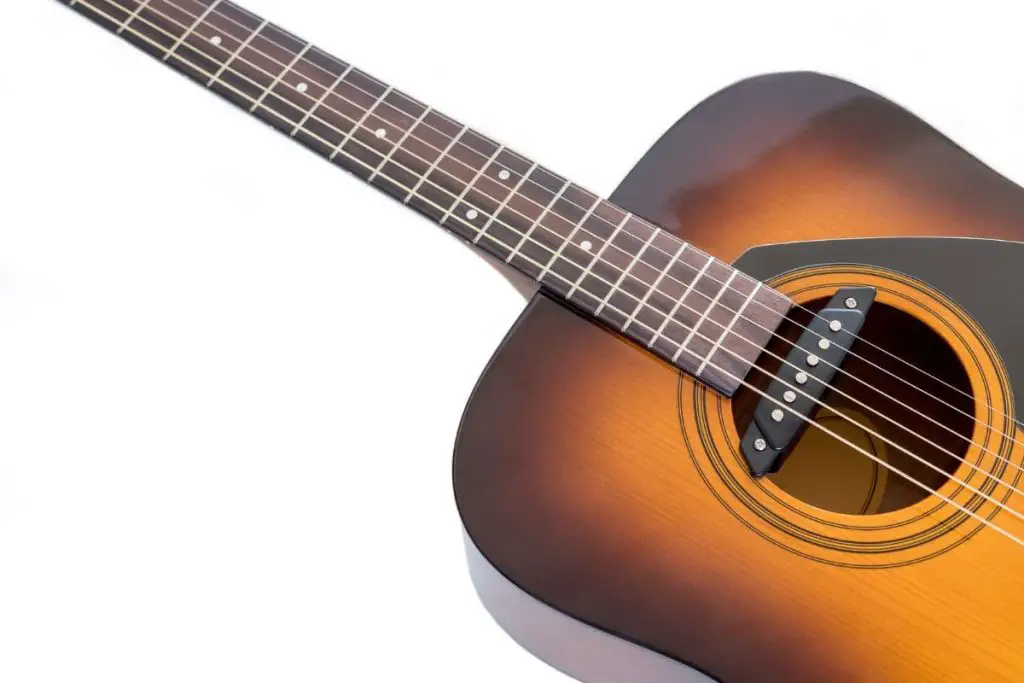
These pickups are electromagnetic, meaning they work the same way as electric guitar pickups. This makes them a great choice if the end goal is to replicate the sound of an electric guitar.
Soundhole pickups are typically not expensive. They’re usually in the range of $50–$250, which is within most people’s reach. They’re also not difficult to install, so you might save some money by doing that as a DIY project. But if you’re not confident in your skills, it’s better to find a guitar technician or luthier who can do this for you.
Eliminating Feedback
Electric-acoustic guitars are prone to feedback. The feedback can worsen if you try to fully electrify your guitar. Therefore, it’s very important that you eliminate potential feedback or at least reduce it if it’s already existing.
The easiest way to do this is by getting a feedback suppressor. A feedback suppressor is a piece of rubber inserted into the soundhole. It’s quite commonly used by guitarists in live settings and does a very good job. It’s also cheap, so it’s a minor investment that can mean quite a lot.
If you prefer something different from a feedback suppressor, you can invest in a noise gate pedal. This is a costlier option, but it does a great job. Noise gate pedals eliminate noise and buzzing in your signal before it gets to the amp, so they can’t cause any additional trouble.
2. Use an Electric Guitar Amplifier
Having turned your acoustic into an electric-acoustic guitar, it’s time to move forward with the steps. You’ll now have to connect it to an amplifier to get an electric sound. Dedicated amps for electric-acoustic guitars exist, but they won’t cut it if you want your guitar to sound like a proper electric guitar.
If your goal is to emulate an electric guitar, then an electric guitar amplifier is the only choice. Once you’ve got an electromagnetic pickup and an amp designed to receive signals from such a pickup, you’ll be much closer to getting the sound of an electric guitar.
It’s best to use a clean tube amp with lots of headroom. Headroom refers to how much you can increase the volume without distorting the sound. The more headroom, the better. At this point, you want to avoid distortion to get as clean a sound as possible.
Once you’ve connected your amp to your almost-electric guitar and it sounds reasonably good, it’s time to turn some knobs and make the sound even more electric. This might require a few minutes to get it right, but tinkering with your sound is usually fun.
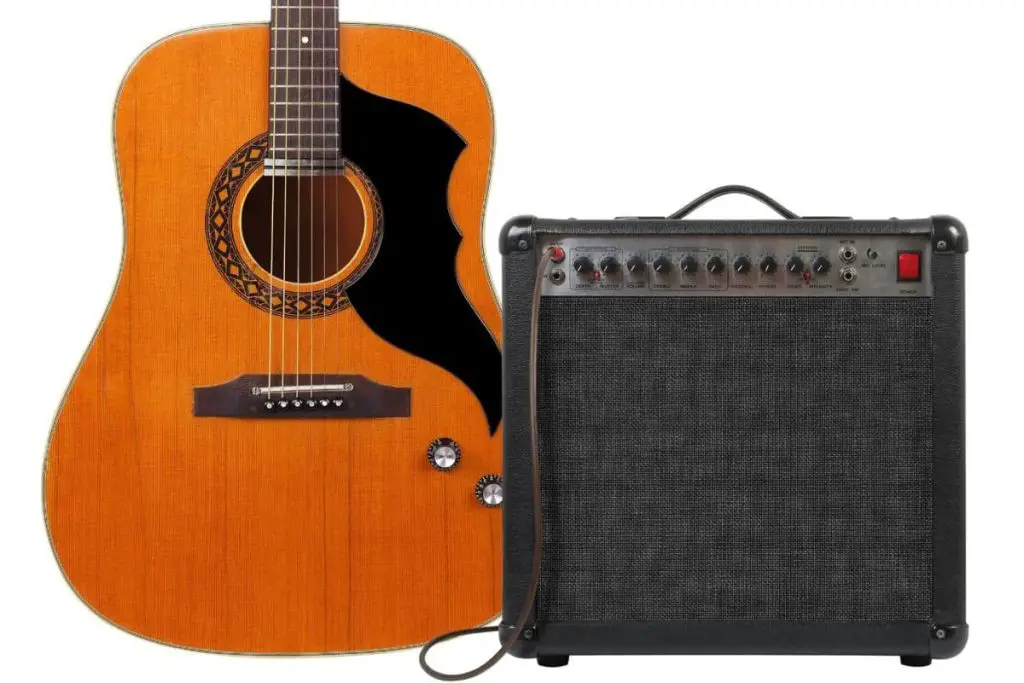
3. Adjust the EQ on the Amp
Acoustic guitars have a much warmer and mellower sound than their electric counterparts. You’ll have to eliminate this to make your acoustic guitar sound more like an electric guitar. The goal is to make the guitar sound sharper and brighter.
Here’s what you should do:
- Turn the treble up: You want to increase the high frequencies as much as possible. This will make the sound much brighter and crisper, which is precisely what we need.
- Keep the mids neutral: Keep the mids neutral. You don’t want them eliminated, but you don’t want too much of them. You can tweak them after you set up everything else if you feel that it’s necessary.
- Turn down the bass: You want to lower the bass frequencies as much as possible. It might not be necessary to turn them down
Of course, the guidelines given here are rough. It’s impossible to prescribe the exact ratios to set your amp. These will depend largely on your amp and the magnets you choose, so you’ll have to experiment a bit and see for yourself. The idea is to aim for as much treble as you can get and the least bass possible.
4. Use Effects
Effects will help you make your guitar sound more like a proper electric guitar. You can use pedals or built-in effects on your amp if that’s an option.
However, you should not go mad with effects. This is not wise even with a regular electric guitar, let alone an improvised one.
The effects you should consider using are:
- Reverb: Reverb gives depth and life to your sound, making it more natural and pleasant for the ear. It’s commonly used on electric guitars, so it will help mask the fact that your guitar is not a regular electric guitar.
- Delay: Delay is another common effect that might make your guitar sound more natural. It’s also a good choice because it won’t put too much strain on your gear and ruin your sound.
- Compression: This effect smooths out your guitar’s sound. Compression increases the volume of the strings you strum lightly. It also decreases the volume of the strings you strum more aggressively, creating a more even sound.
These are just some recommendations. You can use only one of these effects, all of them, or none at all. If you find that your setup sounds great with some other effects, feel free to use those as well.
There are also some effects that you should avoid. Nothing stops you from trying, but they generally don’t sit well with acoustic guitars turned into electric.
These effects are:
- Distortion
- Fuzz
- Overdrive
These effects tend to create a lot of feedback and noise, especially when connected to what is basically an electric-acoustic guitar. They’re prone to feedback already, and connecting them to something that is also prone to feedback and noise will double your chances of running into problems.
If you want to experiment, you can try. These pedals won’t damage your setup; they just tend not to sound very nice. You might just be lucky enough and make them work well, creating something new and interesting.
Some guitarists even manage to get a decent sound from an electric-acoustic guitar plugged into a distortion pedal, which makes it sound much like an electric guitar. On the other hand, you might not be so lucky, and you’ll just get feedback and noise. It’s all a gamble.
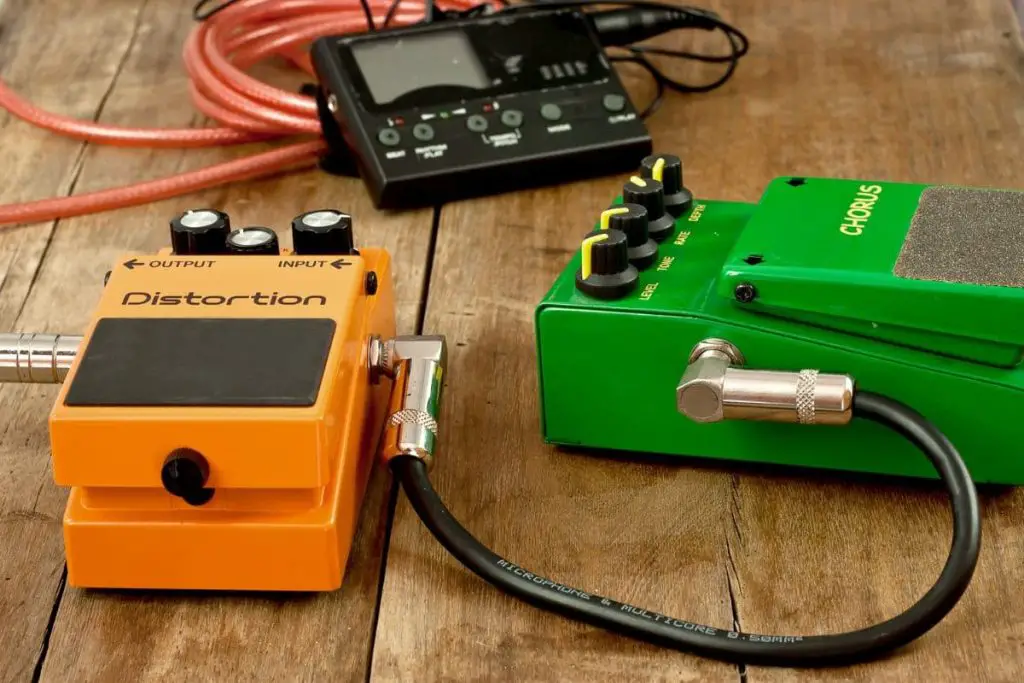
5. Get Different Strings
Electric and acoustic guitars typically don’t use the same strings since the ways they function are drastically different. Acoustic guitar strings usually have a steel base with a brass or bronze plating. On the other hand, electric guitar strings are usually steel or nickel.
To get closer to the sound of an electric guitar, you should use electric guitar strings. You still might get a good sound even if you don’t do this, but you’re guaranteed to get a much better sound with electric guitar strings.
6. Put a Piece of Paper on the Fretboard
Squeezing a piece of paper or a playing card between the fretboard and the strings is an old trick for giving a guitar a slightly crunchier sound. Since that’s the sound you’re looking for, it’s worth playing with some tricks to make your instrument sound a bit crunchier.
Of course, this limits the guitar’s playability since you can only play below the piece of paper. For that reason, you can’t do it all the time. Still, experimenting with it occasionally might give you some nice results.
Some famous musicians used this trick occasionally. For example, Johnny Cash used it sometimes. It must be worth the hassle if it got the job done for such a legend. You can check out a video of Johnny playing guitar like that in this video:
7. Use a Synth Pedal
If you feel like the sound you’re getting still isn’t close enough to a real electric guitar, use a synth pedal to enhance the sound and emulate an electric guitar. A synth pedal can turn the sound of your guitar to the sound of any other instrument, including an electric guitar. In fact, plugging an electric-acoustic guitar into this pedal may be enough to turn your acoustic into an electric one.
Synth pedals used to be very complicated. They required basic knowledge of MIDI and synthesizing, a hex pickup, a special cable, and a ground unit. They were thus unwieldy and difficult to use.
Today, synth pedals work like all other pedals and don’t require additional gear. If you use one, it has to be the first pedal in your chain. That aside, no other limitations exist, and you’ll get a lot of options for playing with your sound.
You can choose between a monosynth and a polysynth pedal. A monosynth pedal, as the name implies, can handle only one note at a time. As you might have guessed, a polysynth pedal handles more than one note at a time. Since a guitar has six strings, a polysynth pedal is the better choice.
The main problem with synth pedals is that they’re usually pricy, so they’re not the best option if you’re on a budget. The money you’d spend on a synth pedal could also get you a decent budget electric guitar, which is the better choice for most people.
Can You Turn a Classical Guitar Into an Electric?
Classical guitars can’t be turned into electric guitars. Unlike regular acoustic guitars, classical guitars use nylon strings, whose vibrations cannot be picked up by electromagnetic pickups. If you replaced the nylon strings with metal strings, you’d probably destroy the sound and, quite probably, the guitar.
Additionally, classical guitarists usually want to preserve the purity of the sound and dislike any changes to the quality they’re used to. The same goes for flamenco guitarists, as tradition is very important in that genre.
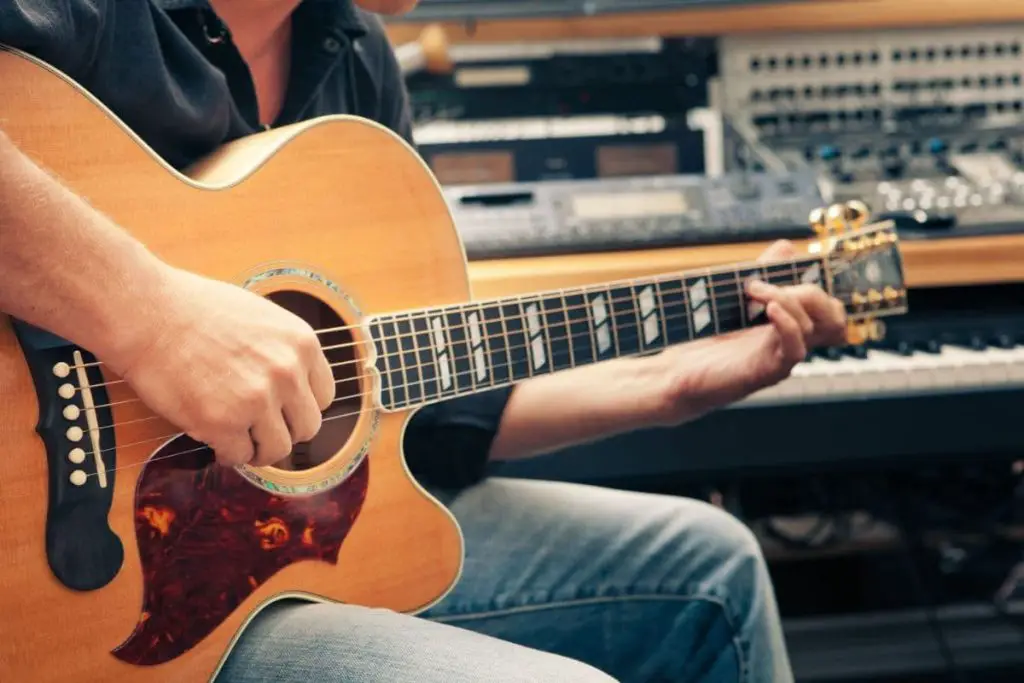
How To Amplify a Classical Guitar
Classical guitars and flamenco guitars are most commonly amplified by miking them. A high-quality microphone will preserve the sound quality of a classical or flamenco guitar while allowing the audience to hear them clearly.
Another way to amplify a classical or flamenco guitar is to add a piezo pickup to it. This is often quite a good solution, as it sounds good and preserves the punch that can get lost if the guitar is amplified with a microphone. It is an even better choice if you have to play with a band because a microphone would also pick up at least some of the sounds around you, which might muddy the sound you’re making.
It’s even possible to mix the two. Sometimes, guitarists will have both a microphone and a piezo pickup. The two signals can be mixed and give you the best of both worlds. This option is particularly good when recording. Classical guitars (just like acoustic ones) are typically recorded with a microphone, but adding a piezo pickup gives some additional strength to the sound.
You shouldn’t do it alone if you want to add a piezo pickup to your classical guitar. It’s generally advisable to get a professional to do it. However, this advice should be treated as a hard-and-fast rule when it comes to classical guitars.
If amplification is really important to you, you can even look for a classical guitar that already has a piezo pickup built in. While this might not be super easy to find, it might be a safer investment than upgrading a classical guitar so that it has a piezo pickup.
Conclusion
That’s all for today. Hopefully, you’ve found the steps I’ve provided in this post easy to understand and will be able to use them to make your acoustic guitar electric without needing to hire a specialist. All the best!
👇😀👇NOTE👇😀👇
If you want to find out what my recommended guitar gear is, then here is what I recommend on Amazon:
- Fender Cutaway Acoustic-Electric Guitar Bundle (MY FAVORITE GUITAR)
- Snark SN-8 Super Tight All Instrument Tuner (Easiest Tuner I’ve Used😏)
- 6 String Acoustic Guitar Capo (Best CAPO for quick changes)
- Dunlop Max Grip 1.0mm Nylon Picks (Thick Guitar Pick So You Don’t Lose Grip!)
- Universal Guitar Stand (Cheap & Minimalist Guitar Stand I Recommend)
- Levy’s 2″ Wide Quick Adjust Guitar Strap (Best Guitar Strap For Any Level)
Related Posts:
